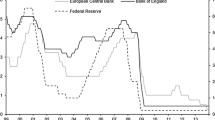Abstract
This study measures the degree of de-facto monetary policy independence of a national central bank. This measurement might allow a central bank to assess the gains and losses in sovereign affecting the national money market when the country’s own currency is given up and a common one is adopted. The study applies a multivariate GARCH-model to the money market rates of six members of the European Union (EU) that have not adopted the common currency. It finds that the central banks of Sweden, Romania, and Poland would not lose considerable de-facto independence by adopting the euro. Their daily money market rates co-move strongly with the euro money market rates, which is a sign of already low monetary policy dependence despite floating exchange rates. This result confirms other research with co-integration techniques, although the coefficients of co-movement with the euro money market are lower in the present study. Lower coefficients can be explained by the impact of non-mean reverting money market rates after heavy shocks in turbulent market periods, which slacken the co-movement ties. The opposite results were obtained for the central banks of the UK, the Czech Republic and Hungary. Hungary is a problematic case: notwithstanding a low co-movement of money market rates with the euro market rates, the almost explosive volatility of money market rates after a shock signals a very poor effectiveness of monetary policy.

Similar content being viewed by others
Notes
Denmark is a member of the Exchange Rate Mechanism (ERM) of the monetary union with a band of ±15 % around the central parity. This restriction on monetary independence could impair the comparison of regression results among countries. Therefore, the country is excluded from this study.
Robor is completely from the Romanian National Bank, and an update of Stibor from the Swedish Riksbank. In these cases, the time observations had to be adjusted to receive continues time orders for GARCH regressions. The value of the last working day has been used for bank holidays.
Of course, I have to acknowledge that the Euribor is not necessarily the lead rate of the Libor—it could be quite the opposite relationship. For all other money markets it seems plausible to understand the euro as the lead currency.
The regression equation has been expanded by lagged Euribor variables.
There might be some undetected multicollinearity between the accession and the float dummy.
References
Black F (1986) Noise. J Finance 41(3):529–543
Bollerslev T (1986) Generalized autoregressive conditional heteroskedasticity. J Econom 31:307–327
Bollerslev T, Engle RF, Nelson DB (1994) ARCH models. In: Engle RF, McFadden DL (eds) Handbook of econometrics, vol IV. Elsevier, Amsterdam, pp 2961–3038
Crespo Cuaresma J, Wójcik C (2006) Measuring monetary independence: evidence from a group of new EU member countries. J Comp Econ 34:24–43
Diebold F (1986) Comment on modelling the persistence of conditional variance. Econom Rev 5(1):51–56
Engle RF (1982) Autoregressive conditional heteroskedasticity with estimates of United Kingdom inflation. Econometrica 50:987–1008
Engle RF (2001) GARCH 101: the use of ARCH/GARCH models in applied econometrics. J Econ Perspect 15(4):157–168
Engle RF, Ng VK (1993) Measuring and testing the impact of news on volatility. J Finance 48:1749–1778
Engle RF, Lilien DM, Robins RP (1987) Estimating time varying risk premia in the term structure: the ARCH-M model. Econometrica 55:391–407
Engle RF, Focardi SM, Fabozzi FJ (2008) ARCH/GARCH models in applied financial econometrics. In: Fabozzi Frank J (ed) Handbook of finance. Wiley, New York
Gabrisch H, Kämpfe M (2013) The new EU countries and euro adoption. Intereconomics Rev Eur Econ Policy 48(3):180–186
Gabrisch H, Orlowski LT (2011) Extreme risks in financial markets and monetary policies of the euro-candidates. Comp Econ Stud 53(4):511–534
Goczek Ł, Mycielska D (2013) Ready for euro? Empirical study of the actual monetary policy independence in Poland. University of Warsaw Faculty of Economic Sciences Working Papers No. 13/2013 (98)
Goczek Ł, Mycielska D (2014) Monetary policy and nominal convergence in CEE countries with inflation targeting. Economia nr 38:31–44
Habermeier K, Kokenyne A, Veyrune R, Anderson H (2009) Revised system for the classification of exchange rate arrangements. IMF Working Papers, WP/09/2011
Hayward R (2014) Towards a model of speculation in the foreign exchange market’. Dissertation thesis, University of Brighton, Business School
Kiss GD, Kosztopulosz A (2012) The impact of the crisis on the monetary autonomy of Central And Eastern European countries. Public Finance Quarterly LVII(1):27–51
Lamoureux CG, Lastrapes WD (1990) Persistence in variance, structural change and the GARCH model. J Bus Econ Stat 8(2):225–234
Mutu S, Bresfelean VP, Göndör M (2011) The impact of the financial crisis on the interbank money markets behavior. Evidence from several CEE transition economies. MPRA paper no. 42102. 15. Online at http://mpra.ub.uni-muenchen.de/42102/
Nelson DB, Cao CQ (1992) Inequality constraints in the univariate GARCH model. J Bus Econ Stat 10(2):229–235
Orlowski LT (2012) Financial crisis and extreme market risks: evidence from Europe. Rev Financ Econ 21(3):120–130
Plümper T, Troeger VE (2006) Monetary policy autonomy in European non-euro countries, 1980–2005. European Union Politics 7:213–234
Reade JJ, Volz U (2011) When you got nothing, you got nothing to lose—regional monetary integration and policy independence. In: Volz U (ed) Regional integration, economic development and global governance. Elgar, Cheltenham, pp 274–294
Acknowledgments
The author would like to thank Herbert S. Buscher, Lucjan T. Orlowski and an anonymous referee for useful comments. The article has also benefitted from comments at presentation at the 2014 conference of the Austrian Economic Association in Vienna and at the 2014 Infiniti conference on international finance Prato, Italy. All remaining errors are the responsibility of the author.
Author information
Authors and Affiliations
Corresponding author
Rights and permissions
About this article
Cite this article
Gabrisch, H. Monetary policy independence reconsidered: evidence from six non-euro members of the European Union. Empirica 44, 567–584 (2017). https://doi.org/10.1007/s10663-016-9337-3
Published:
Issue Date:
DOI: https://doi.org/10.1007/s10663-016-9337-3




